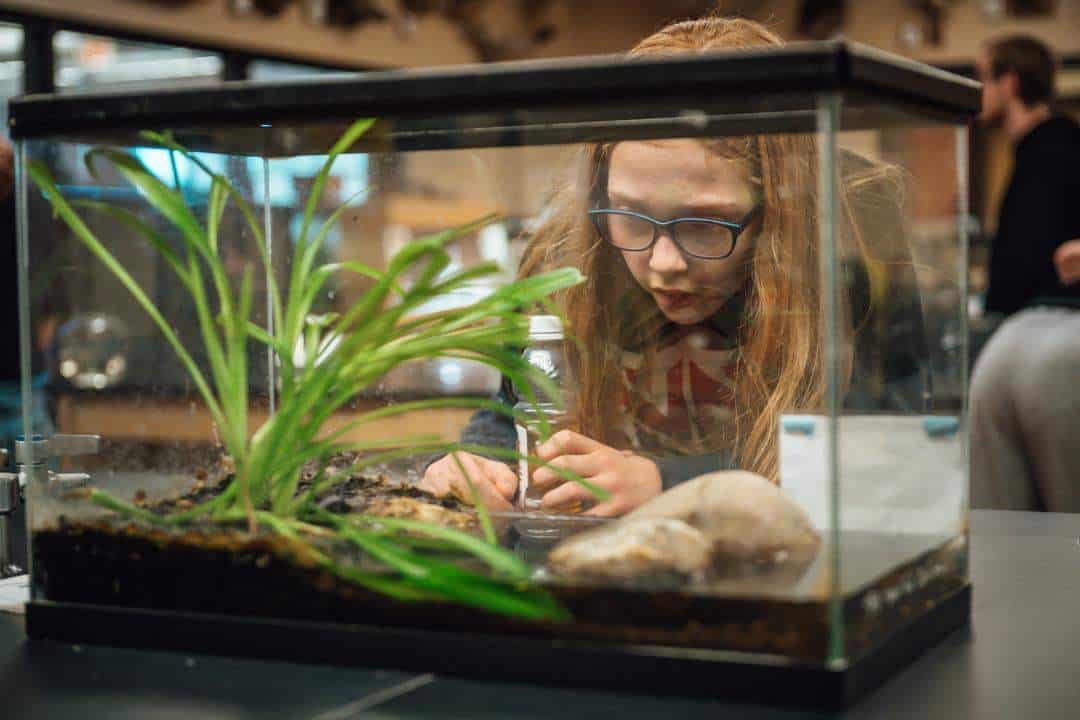Dr. John Cossel
208.467.8893
jocossel@nnu.edu
Department of
Biology
Department of Biology
From teasing out the details of disease mechanisms to understanding enzyme kinetics to determining the habitat needs of sensitive species, we live, learn and love everything biology-related!

Department of Biology
“Let the heavens be glad, and let the earth rejoice! Let the sea and everything in it shout His praise! Let the fields and their crops burst forth with joy! Let the trees of the forest rustle with praise before the Lord!” —Psalm 96:11-13 (New Living Translation)
The excitement described by the Psalmist above also illustrates how delighted the biology faculty at Northwest Nazarene University is about discovering the intricacies of God’s handiwork. From teasing out the details of disease mechanisms to understanding enzyme kinetics to determining the habitat needs of sensitive species, our faculty love biology! One of our greatest satisfactions is found in helping our students grow in their knowledge as they work to receive their biology degree, all while nurturing their faith and preparing them to succeed in their professional endeavors.
NNU’s Biology department offers areas of study in Biology, Biochemistry, Wildlife Biology/Ecology, Pre-Medical, Pre-Physical Therapy and Biology Education with academic rigor, hands-on research opportunities at the undergraduate level, direct access to highly-qualified, caring professors who provide support throughout the transition between graduation and career or onto graduate school, and unmatched outcomes with a >90% acceptance rate into medical, dental and veterinary graduate programs.
Bachelor’s Degree Options
Department Goals & Student Outcomes
- Graduates who receive a biology degree from Northwest Nazarene University will demonstrate that they can think logically, analytically and independently about the scientific principles that affect the world around them. Graduates will acquire a basic informational framework to make decisions related to such areas as nutrition, personal and family health, community policy and national law.
- Graduates who receive a biology degree from Northwest Nazarene University will be able to collect and analyze scientific data and then integrate and prepare the data into professionally acceptable written and oral forms. Students will become comfortable in the utilization of modern technology to more effectively communicate.
3. Graduates who receive a biology degree from Northwest Nazarene University will develop a historical sense of scientific advancement through a better understanding of natural phenomena and then apply this knowledge through a variety of scientific endeavors to accurately understand, utilize, control and predict natural processes in a way that will allow the realization of a better quality of life.
4. Graduates who receive a biology degree from Northwest Nazarene University will integrate scholarship, faith and service by exposure to a community of scholars, and develop long-term personal, spiritual, professional and social interactions that allow mutual expression of the Lord’s redeeming grace. Students should then be better able to excel in their chosen discipline and be effective and compassionate members of their community.
Meet the Team
Current Research Led by NNU Faculty
Dr. Ayokunle Hodonu, DA, MS
Two-week Summer Scholars Program: Students will have an opportunity to learn molecular biology and basic bioinformatics skills in the context of amphibian phylogenetics. Although amphibians seem to be a fairly well-known taxon, there remain many species yet to be formally described. A key approach to recognizing and describing new species is an understanding of phylogenies based on genetic data. In this project, students will complete tissue/cell sample collection and DNA extraction. Sequences of targeted genes will be obtained, and sequencing results will be used to construct phylogenetic trees. This experience will provide a good basis for understanding important concepts in the modern field of biological systematics.
Physiological Research: Understanding uterine physiology from breeding to implantation to pregnancy can lead to many agricultural and medical advances and breakthroughs. Problems such as small litter sizes, infertility in humans and livestock, birth control, gestational diabetes and Polycystic Ovarian Syndrome (PCOS), can be better addressed by concerted investigation of hormonal and physiological factors that affect the uterus in early pregnancy. Our lab focuses on understanding and determining the optimal uterine conditions for embryo implantation, using the American mink (Neovison vison) as a biological model. We explore and investigate the different hormones that act on the uterus, the synthesis and mobilization of glycogen during early pregnancy, and the underlying physiological mechanisms that facilitate reproductive success. We explore the role of hormones such as insulin (a traditionally non-reproductive hormone), IGFI, IGFII, etc., their interactions with sex hormones, possible effects on the mink uterus and their role in glycogen metabolism.
To better understand the effects of these hormones on the uterus, our lab utilizes immortalized mink uterine epithelial cells (GMMe) to investigate the effects of ovarian hormones on insulin receptor expression. There is evidence that most of the glycogen in the uterus is accumulated in the luminal and glandular epithelial cells of the mink uterus (Rose et al., 2011; Dean et al., 2014). Thus, the use of immortalized cells allows us to further investigate how glycogen is stored and mobilized in the uterine epithelium. We use techniques such as Quantitative Polymerase Chain Reaction (QPCR) and glycogen assays to investigate how these hormones interact and affect receptor expression in GMMe cells. We also examine the effect of these hormones on glycogenic and glycogenolytic enzymes during the reproductive cycle.
Minimum classes: General Biology 1 and 2; Recommended – Cell Biology or Genetics
Dr. Jennifer Chase, Ph.D., MSc
The cells of the uterine endometrium are responsible for providing sugars and their derivatives to the developing embryo before and even after implantation. The storage of sugars (as glycogen) and delivery of glucose, pyruvate, and lactate is regulated by estrogens, progesterone, and possibly other hormones. Although dysregulation of these metabolic pathways may be a cause for infertility, the regulation is not yet understood. Students will help to develop a valid computer model of regulation of carbohydrate metabolism in mink or human uterine cell lines. Students may be tasked with caring for the cultured cells at various hormone levels, measuring enzyme kinetic constants, or measuring the production of, or steady-state levels of, metabolites in cultured cells. The measurements will become parameters of a computerized model that will then be used to develop hypotheses that can be tested about mechanisms of regulation and to predict which enzymes might be good therapeutic targets or identifiable risk factors for infertility. Biochemistry experience is preferred, but students who have taken at least general chemistry will be considered for positions.
Dr. John Cossel, DA, MS
Bioacoustics of Anurans in Costa Rica and Panama: Acoustic communication is very widespread among anuran amphibians. There are various types of calls including territorial, defensive/alarm, courtship and advertisement calls. Understanding how species use these calls is necessary to have a complete natural history. Further, calls can help distinguish unique species when cryptic species occur syntopically. For many species, call characters and behavior are well known. However, there remain species for which this information is lacking. In summer 2018, my lab observed anurans (frogs and toads) in Costa Rica and Panama. Our field studies targeted the collection of anuran calls using digital audio recorders. We captured the individuals for which we have audio recordings and obtained morphometric data, tissue and/or swab samples for genetic analysis. We also used various field equipment to measure environmental variables (air temperature, humidity, etc.) and utilized audio analysis software (Raven Pro and/or R seewave) to characterize calls. These analyses coupled with our field observations should result in publications that describe these natural history features for the first time. Target species included: Ecnomiohyla fimbrimembra, Craugastor melanostictus, and Pristimantis caryophyllaceus in Costa Rica; in Panama we targeted Pristimantis gaigei and Agalychnis lemur.
Reptile Communities in the Snake River Birds of Prey Area: Reptiles are an important component of terrestrial ecosystems both as predators and as prey. Generally, species are well adapted to the habitats in which they occur. However, due to anthropogenic changes, the landscape has changed in many areas in southwestern Idaho. A prime example of this is the extensive conversion of former desert shrublands to areas dominated by exotic annual weeds. The effect these changes have on reptile communities is largely unknown. This research will be a cooperative effort with Boise State University, the Idaho Army National Guard, and the United States Geological Survey to survey much of the northwestern portion of the Snake River Birds of Prey National Conservation Area. We will utilize drift fence trapping arrays to capture snakes and lizards at various sites that have been surveyed in previous decades. Trapping efforts will also be supplemented with data obtained by visual encounter surveys, road encounters and targeted searches. These data will inform land managers of the impacts vegetation changes have had (if any) and may direct future management efforts.
Dr. Jamee Nixon, Ph.D., MS
For this project, different metal nanoparticles will be evaluated as antibacterial agents. Silver and zinc oxide nanoparticles will be tested for the antibacterial efficacy on a variety of bacteria strains, including E. coli and Staphylococcus species. The two main methods to test the antibacterial properties of the nanoparticles will be through disk diffusion and broth dilution assays. Broth dilution test: To test the potency of ZnO as an antibacterial agent, the minimum inhibitory concentration (MIC) will be obtained. The MIC will be obtained by conducting a broth dilution test. Bacterial organisms will be grown up on LB plates. Single colonies of bacteria will be transferred to LB broth. Fresh LB broth will be mixed with various concentrations of ZnO. To obtain the desired concentrations of ZnO, ZnO will be serially diluted beginning with a concentration of 1.0 µg/L and ending at a 0.0625µg/L. Once the dilutions have been made, each test tube will be inoculated with an identical amount of test bacterium by adding broth cultures. The tubes will be incubated and the turbidity of each tube will be measured visually and/or by an ELISA plate reader.
David Hille, MS
Biology and Conservation of Common Nighthawk (Chordeiles minor): Understanding the biology and conservation issues of the Common Nighthawk (Chordeiles minor) is becoming increasingly important. The 2014 State of the Birds Report for the US classifies the species as common but in a steep decline. North American Breeding Bird Survey data records a 61% decline from 1966 to 2014. To know how to better preserve their populations across their breeding range in North America we need to understand why populations are declining so drastically. We explore the effect of habitat on nest choice and nest success. The Morely Nelson Snake River Birds of Prey National Conservation Area and the BLM-managed Owyhee foothills provide a large study area with varied land use creating different habitat qualities to test the impact of land use on breeding sites and success in southwestern Idaho. Additionally, we monitor behavior such as arrival and departure dates, courtship activity, and foraging activity using automatic recording units (ARUs) to gain a better understanding of how they use the study area on a seasonal basis.










